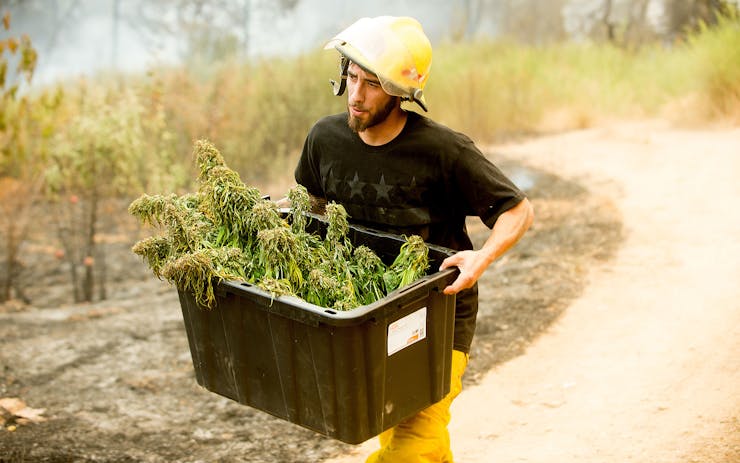Last month the Biden administration proudly announced that farmers hit by natural disasters over the past two years would start receiving relief payments from a $6 billion injection into the USDA’s Emergency Relief Program.
“Farmers and ranchers across the country have been hit hard by an ongoing pandemic coupled with more frequent and catastrophic natural disasters,” Agriculture Secretary Tom Vilsack said. These new funds will “inject financial support back into the rural economy” to farmers who lost crops due to drought, wildfire, smoke damage, flooding, and winter freeze.
New funds will help farmers recover from wildfire and other disasters. But not if you’re growing legal marijuana.
The support is expected to be especially welcome in the American West, where wildfires and smoke wiped out many crops in 2020 and 2021.
There’s only one hitch in the program, though. State-licensed cannabis farmers, whose outdoor crops in the West were severely damaged by wildfire, aren’t eligible to receive a single penny of relief.

In an email to Leafly, a USDA spokesperson confirmed that there’s no way for cannabis growers to receive any of these funds—no matter how much damage or destruction their crops may have suffered.
“Marijuana is a controlled substance, and therefore is not eligible for federal farm programs,” a USDA spokesperson wrote in an email. “Hemp,” the spokesperson noted, “is eligible for farm programs.”
Hemp is cannabis with less than 0.3% THC, but it’s not state-licensed cannabis—which, as Leafly noted last year, now comprises America’s fifth most valuable crop.
Hard to find insurance, impossible to get federal aid
America’s cannabis farmers are critical players in the effort to end illicit marijuana sales and move consumers into the licensed, lab-tested market in 19 legal states.
But because of federal prohibition, they’re forced to take on risks no other farmers must bear. Those risks include these two economic gambles:
- State-licensed cannabis farmers aren’t eligible for federal crop insurance.
- These farmers are also prohibited from receiving help from the federal Noninsured Crop Disaster Assistance Program, which helps farmers whose uninsured crops are damaged or lost due to natural disasters.
That forces cannabis farmers to turn to the private insurance market, but many find that insurance ruinously expensive—if it’s offered at all.
Private insurers have been discouraged from backing cannabis businesses due to the state-federal legal conflict.
According to the Center for Insurance Policy and Research, private insurers have been discouraged from backing cannabis businesses due to “conflicting state and federal laws” and “rapidly evolving regulations.” The organization notes that cannabis producers face the same general liabilities and risks as other farmers, such as “workplace accidents, damage to property and crop failure.” Cannabis operations are “especially prone to fires from both wild and internal sources,” according to the research center.
With no federal assistance available, and private insurance difficult to come by, there seems to be very little protection for recovering farmers in the industry.

Legal states offer no help either
In Washington state, the legal status of cannabis doesn’t gain its growers any state-level public assistance either, according to Washington State Liquor and Cannabis Board spokeswoman Julie Graham, who cited information from the state’s Department of Commerce. The commerce department itself did not respond to an email asking what resources or aid might be available.
Private insurers may cover a cannabis business’s liability and property but exclude the actual crop and resulting products, according to the Washington State Office of the Insurance Commissioner. These businesses are required by the state to purchase some coverage, albeit quite limited. “The sale of cannabis is legal in Washington state,” the agency states. “However, some insurers won’t offer you coverage because the federal government still considers it an illegal substance.”
“Coverage may only be available from high-risk, non-Washington licensed insurers called surplus line insurance companies,” which are entities that cover especially risky things like a house built on the side of a steep hill or rare art, according to the agency.

Lack of insurance may lead to greater personal risk
That lack of crop insurance doesn’t just put farmers at risk of economic ruin. It can lead some to put their own lives in danger. Consider, for instance, the story of Washington state cannabis farmer Terry Taylor.
When there’s no insurance, farmers can end up needlessly risking their lives to save their property.
When a massive wildfire tore through Washington’s Okanogan County in late 2020, Taylor jumped into action. The farmer and former firefighter knew the Cold Springs Fire could destroy his family’s home—and livelihood.
“It was our whole life,” Taylor said of his company, Okanogan Gold. “We’ve spent the last seven years building this whole facility, and we didn’t want to see it go. If we knew we had insurance, we would’ve just said ‘OK, let’s just go.’”
Instead, Taylor risked his life working to save the 38-acre property, staying there after Okanogan County sheriff’s officials warned him to evacuate at 2:30 a.m. on Labor Day.

$500,000 in crop damage from wildfire
Taylor was fortunate. He didn’t lose everything. The wildfire burned more than 290 square miles near his farm, but spared his home and facilities. He said his operation suffered at least $500,000 in crop damage and another $10,000 in physical damage to equipment like irrigation pipes.
“All of the cannabis was damaged,” Taylor said. “It was full of dirt because we had 50-mph winds, and it was pushing dirt and ash. We couldn’t use it as the flower it was intended to be,” explaining that the plants ended up being categorized low-grade and had to be used mostly for cannabis oil extraction. “Most of it got sold at very low prices,” he said.
“If we would’ve lost everything in that fire, we would’ve had nothing,” he said, describing 200-foot flames on the other side of the Okanogan River, near his property. “I mean, that’s the reality of it.”

Cold shoulder from officials even in legal states
Even in America’s most well-established legal states, public officials who eagerly tout the relief offered to all other farmers go strangely silent when it comes to cannabis farmers.
Sen. Patty Murray (D-WA) last month issued a written statement praising the USDA’s disaster relief funds, noting that roughly $191 million would go to farmers in her state alone.
“I’m glad we could bring back some badly-needed federal dollars to help our farmers
and ranchers during a really tough time,” Sen. Murray said. “I will always have the backs of Washington state farmers who keep food on our tables and our families fed.”
Terry Taylor and other cannabis farmers, of course, will be excluded from the help extended to Washington’s other farmers.
That’s despite the fact that legal cannabis is estimated to be the fourth highest-earning cash crop in Washington, with a production value of $653 million in 2020, according to the 2021 Leafly Cannabis Harvest Report.
“It’s brutal,” he said. “And lately, we’ve been kinda used to it.”
Heat-related losses given special attention
Last October, Sen. Murray asked federal officials to offer help to agricultural producers not included in past relief programs. She co-authored a letter with three Congress members from her state, asking for aid to be given to “producers who suffered some of the greatest heat-related losses.”
This includes those who are “either located in counties not covered by the drought designations, experience losses not covered by drought assistance programs, or both,” the letter states.
After receiving the letter, federal officials decided to offer aid to “underserved producers who have been left out of past relief efforts,” according to the USDA Farm Agency’s description of the Emergency Relief Program.
Even so, cannabis farmers continued to be excluded. Murray’s office did not respond to an email asking if she has lobbied to get federal aid for these growers, or if she has any plans to do so, given the crop’s importance to the state’s agricultural economy.
The fact that cannabis farmers have been ignored by these efforts went unacknowledged by the senator as she applauded the program’s launch last month.
The challenges don’t stop
Meanwhile, growers throughout the West continue to grapple with extreme weather and other challenges.
“This year has been really brutal for everyone, just with the prices going down and the fires from last year, recovering,” Taylor told Leafly. The weather this year has been so cold, he said, that it’s stunted the growth of his crop. “Our auto flowers were three feet tall at this time (last year), and this year, they’re three inches tall. Some were planted last month, and they’re like we just put them in the ground.”
Canopy limits under state regulations have also forced the farm at Okanogan Gold to cut its production by about half – from 75,000 auto flower plants last year to 25,000 this year, Taylor said. Those regulations, along with the poor weather conditions, will make it extremely difficult for smaller growers to survive, he added.
“We’re going to probably be able to hold on because I don’t have any debt,” Taylor said. “But the people that owe on the property and everything – I think it’s going to be a house of cards.”





